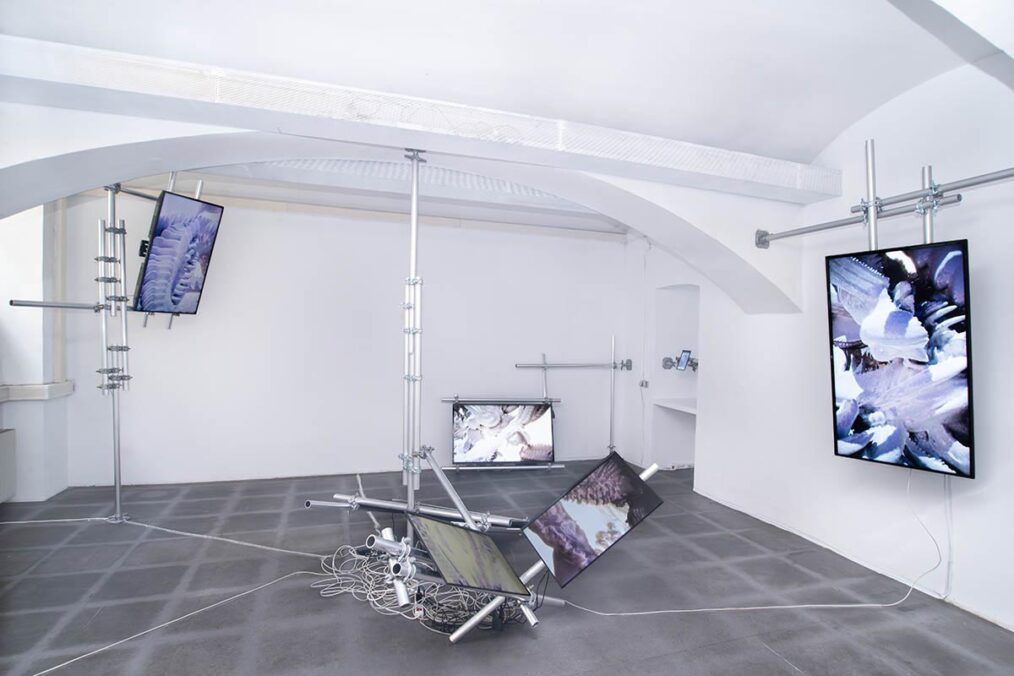
We as the room69 collective are convinced that the digital world is not a closed space, but is fluid and confronted with temporalities. In lost to the digital ether, we use the digital sphere and infrastructure of Google Maps as an archive and preserve the immaterial space and our previous work as a collective.
This virtual terrain is an ever-expanding, constantly growing desert that fictionalizes the white cube and O’Doherty’s original approach: Nothing exists here to distract from what is present, everything moves into the center of attention without influence. Only on closer inspection are the gaps between the bytes that make life and fiction possible, allowing growth. Just as analog white spaces are not neutral, neither are they in digital space. Through fog, we blur the infrastructure and thus highlight the ever-expanding, light and airy particles.
How does the archive material behave within the expandable walls of virtual space? What temporality is the digital and institutional infrastructure confronted with? In the work of the collective, the concepts of building a virtual world, collectivity and a constantly expanding artistic process are central to the work. For the installation, room69 meditates on loss and forgetting and creates a virtual archive as a liminal space for collecting and exhibiting artworks. Over the course of a year, the collective will set up an immersive stage in which artworks by the collective are archived, but forgotten and lost to the digital ether – to be found and discovered over time.

About the work:
The collective room69 works between the worlds of physical space and virtual world-building. Within their practice they use a variety of mediums that activate physical space with virtual / digital interventions and objects. Often employing the use of spatial sound, 3D prints, computer generated landscapes and notions of world-building, the collective seek to position their work within the canon of Phydigital art (that is to blend and intersect two or more worlds into one)
In lost to the digital ether, room69 has created a 6-channel video installation that pieces together the makings of an archival repository for the collective. Starting as a basis in which all their work will live, the installation focuses on topics of loss, forgetfulness and ultimately exploration. Each installation, exhibition or intervention by the collective is always new, in doing so they create a multitude of works that are experienced either online forever, or momentarily within a space. By creating this archive, they posit the question as to what is a collection of digital works and how they can occupy virtual space.

The 6-channel installation features an almost endless landscape in which the collective and their works exist. room69 sees the possibilities and realities of the digital world as fluid and confronted with temporalities. On one hand we see the aesthetic sensibilities the collective is known for, 3D rendered open space and on the other we find a field in which the collective speculate upon and archive their material. The collective is often finding ways to invent and re-invent their practice and this installation lays bare the foundations of that artistic process.
The installation also bodes well to the collective’s intentions of blurring the often fixed and formal dimensions of the white cube, through refiguring the binary and opening up possibility for art and artistic practice to emerge behind and furthermore beyond. Just as analog white spaces are not neutral, neither are they in digital space.
Within their often speculative working method, lost to the digital ether acts as a space between life and fiction, allowing growth for the expansion of their artistic practice.

Additionally, room69 have used Google Maps to make the archive accessible to viewers across the globe. This speaks strongly to their working mode of creating / intervening and using spaces for other than what they were intended for. To activate sites with art, knowledge and digital culture. Particularly for lost to the digital ether, we use the digital sphere and infrastructure of Google Maps as an archive and preserve the immaterial space and our previous work as a collective. The collective have created the concept of “virtual squatting” as a tool for exhibition making and artwork display. Within this concept, room69 have launched various exhibitions on Google Maps that were often tied to a physical extension. Namely with exhibitions / locations in Belgrade RS, Los Angeles USA, Fano, IT and Vienna, AT (which is also where the collective are based.) These exhibitions are currently online and can be accessed to view works by the collective and other artists they have invited.
The installation is also mounted on industrial constructions — reinforcing the idea of the collective’s desire to build, add, and reconfigure.
Exhibition: lost to the digital ether curated by Alexandra Grausam
Exhibition duration: 7.11.2023 until 27.1. 2024
Find the dwhX commission on Google Maps here.
Address and contact:
das weisse haus
Hegelgasse 14, 1010 Vienna
www.dasweissehaus.at
dwhX is a new digital platform conceived by the art association das weisse haus. It is dedicated to the collective experimentation, the support of and reflection on arts and culture in relation to digitality. dwhX embodies a hybrid organism with changing rhythms and intensities, and hosts a range of different programs with varying lifetime. It is born out of the acknowledgement that contemporary human life neither exclusively manifests in the physical world, nor entirely in the digital. Interdependent with dwh’s physical exhibition space in Vienna, Austria, dwhX confidently positions itself as a necessarily incomplete and continuously learning entity. The platform grows thanks to the ongoing dialogues with an intersectional cohort of artists, designers, developers, curators, theoreticians, hackers, gamers, lovers and opponents of the digital and in cooperation with partners. www.dwhx.space





